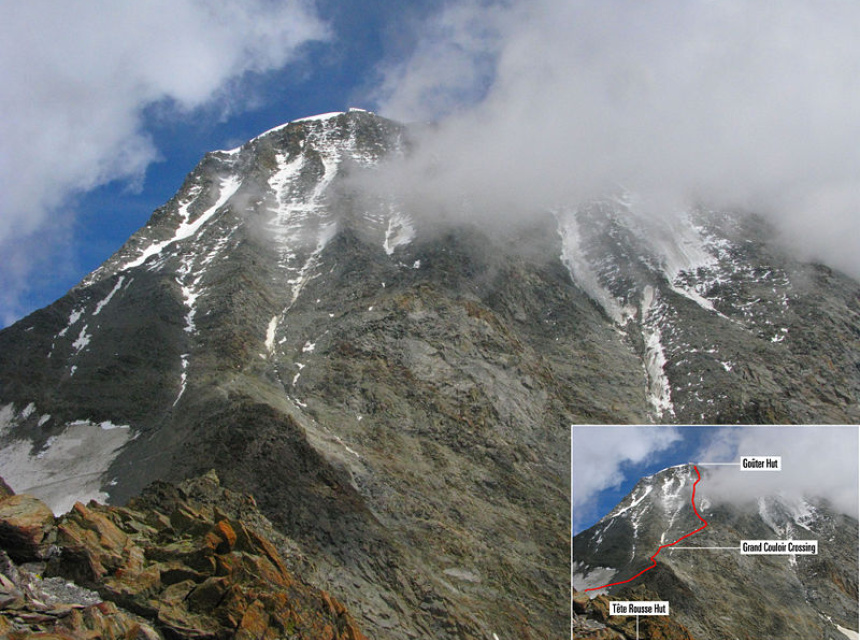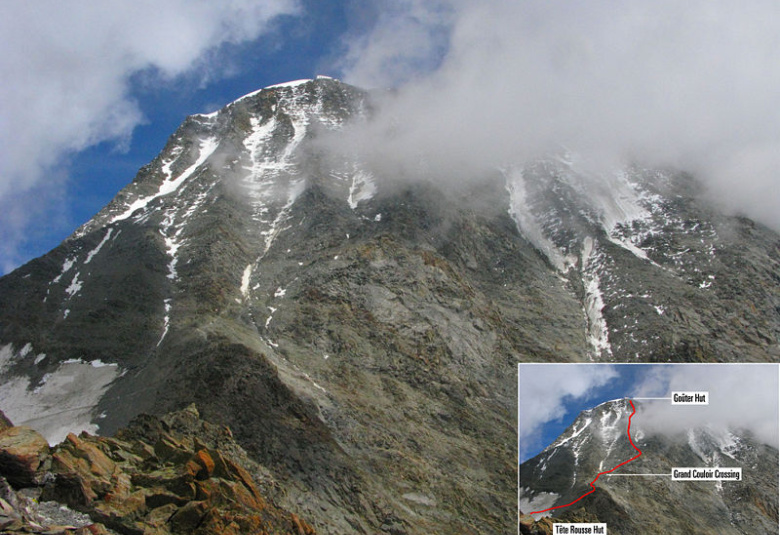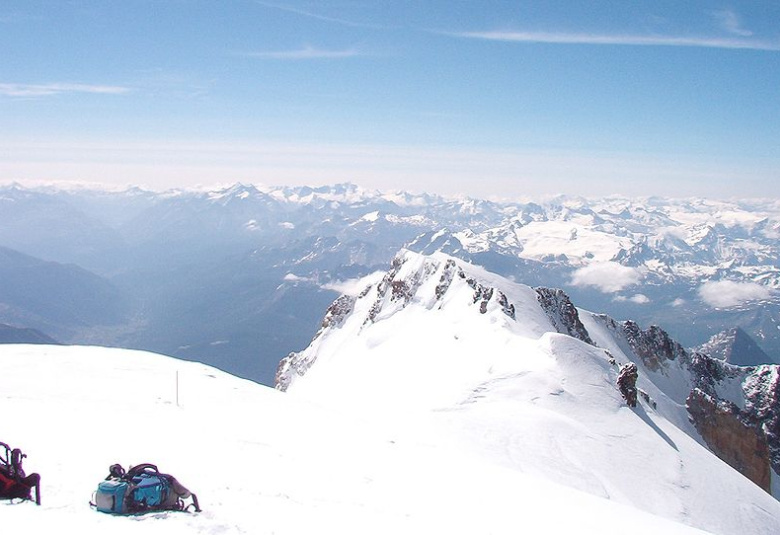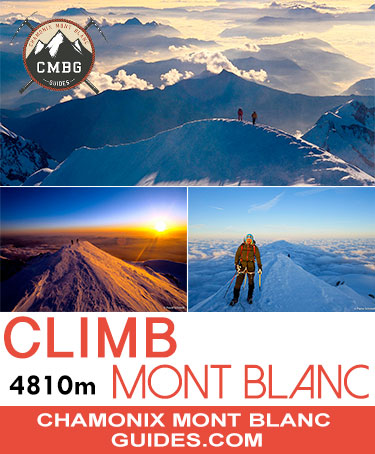Chamonix is dominated by the majestic peak of Mont Blanc, 4,810m high, the highest mountain in western Europe.
Every year, the summit of Mont Blanc becomes the ultimate objective for mountaineers from all over the world, all striving to stand on the top of Europe and look down at all of the major summits of the Alps.
People normally choose one of the two most common routes to climb Mont Blanc from Chamonix. The route from the Aiguille du Midi, over Mont Blanc du Tacul and Mont Maudit is generally quieter, and highly dependent on conditions, but slightly more technical.
The slightly easier and more reliable option is via the Tramway du Mont Blanc to the Nid d'Aigle, then up the Aiguille du Gouter and the Bosse ridge, but be aware of serious rockfall hazards in the Grand Couloir of the Aiguille du Gouter..
While not technically challenging, ascending Mont Blanc requires a high level of physical fitness and experience using crampons and an ice axe.
1. Climbing Mont Blanc - Gouter Hut Route
This is the classic and most popular route to climb Mont Blanc. Remember that you need to book in advance the Gouter Refuge. The hut is open from the beginning of June to the end of September. Bookings can ONLY be made online.
Take the Bellevue cable car from Les Houches and then take the Tramway du Mont Blanc to the Nid d'Aigle (2,372m) (here you can find the rates for cable car and the tramway). From here there is about 5 hours of walking/scrambling to the Gouter refuge (3,817m).
The first section is easy walking terrain on a well established path. Just after the Tête Rousse refuge, cross the infamous Grand Couloir where there is often rock fall from above.
The last 550m from here is scrambling rather than walking and not always easy, especially on the descent, because of the tiredness. Early on the second day, leave the Gouter hut and from here on there is glaciated terrain and crampons are required, with harnesses and ropes.
Most of the ascent is a long slow plod without any steep ground to encounter. Walk past the Vallot shelter, an emergency bivouac, and then climb along the Bosses ridge, the two lumps which form the distinctive skyline seen from the valley.
This is an exposed ridge which requires concentration and good crampon technique. This route takes about 4 hours and a half to reach the summit.
There are two choices for the way down, back to the Aiguille du Midi or back down on the same route.
A mountain guide takes a maximum of two clients on the mountain. Contact the Chamonix High Mountain Guides for further information.
On 17th August 2017, the mayor of Saint-Gervais, Jean-Marc Peillex, issued a municipal order with immediate effect stating that "anyone attempting to climb Mont Blanc via the Gouter Route must have a minimum level of equipment and clothing". Any offender will get a €38 fine.
Mont Blanc route kit list: hat, sunglasses, ski mask, sun cream, warm and waterproof jacket, mountaineering trousers and base layer, mountaineering-specific boots and crampons, harness and crevasse rescue equipment, rope, ice axe, GPS or altimeter.
Video from the Mont Blanc Ascent via the Gouter Hut @ Courtesy Odyssee Montagne
For Reservations:
Tete Rousse Hut - Tel: +33 (0)4 50 58 24 97
The Gouter Refuge
Guardians: Antoine Rattin, Email: refugedugouter@ffcam.fr, Tel: +33 (0) 4 50 54 40 93, Website: refugedugouter.ffcam.fr.
For people wanting a complete trekking guidebook, or to explore the finest routes up the Mont Blanc, also in hardcover or kindle edition, follow this link. Don't forget to take a map.
2. Cosmique Route: the 4,000m traverse
To climb Mont Blanc using the Cosmique route, take the cable car to the Aiguille du Midi (3,842m).
From here, descend the Aiguille du Midi arête to the glacier du Tacul, where there is approximately 1 hour walk on easy terrain to the Cosmique Refuge (3,613m). Early on the day after, start climbing the Mont Blanc du Tacul.
This ascent can be difficult at times. Due to warm temperatures, in recent years more crevasses have opened up and, at times, this has required climbing on some steep exposed terrain.
After reaching the shoulder of Mont Blanc du Tacul descend and traverse the Col du Mont Maudit. From here, ascend a long snow slope to the final piece of technical ground, which can be very steep and requires good front pointing technique and use of an ice axe. Watch out for a bottleneck of mountaineers here!
Descend once again to Col de la Brenva, with stunning scenery towards Italy, then climb the last few hundred metres to the summit.
Although relatively easy, this is generally quite slow due to the effects of altitude. This route takes approximately 6h to the summit. Descend the same way or via the Gouter, completing the traverse of Mont Blanc.
This is a slightly more demanding route than the Gouter route, both technically and physically. Tackle steeper ground and there are a couple of traverses that may be icy and difficult. Good crampon and ice axe technique are essential. It is, however, a more interesting route with beautiful scenery and is less crowded.
The Cosmique Refuge can also mean a better night's sleep, and can be less busy than the Gouter Refuge. This is a route which is long and sustained, less popular than the classic route, but which traverses the roof of Europe.
The ideal period is from March to September (depending on conditions) 5 - 8 hours of ascent, 3 - 4 hours of descent. 1,300m of ascent, 3,800m of descent.
Difficulty: AD - D, a variant which demands good technique, experience and fitness.
For Reservations:
Cosmiques Hut: Alt - 3,613m - Tel: +33 (0)4 50 54 40 16 February - early October 1/2 hr from the Aiguille du Midi cablecar
3. Climb the Mont Blanc in Winter - Grands Mulets Route
Climb up a famous route with a snowboard or a pair of skis, such as "The Three Mont Blanc's", "The Descent of the North Face" or "The Corridor Route".
The most frequented and most dangerous is the Classic Route via the Grands Mulets hut at 3,051m.
The first ascent of the Mont Blanc on skis was via the classic route in 1904 by Ugo Mylius with Oberland guides: Tannler, Maurer and Zurfluh.
The first descent from the summit on skis was by a Swiss guide, Elias Julen in 1930. Marco Siffredi popped up to the Blanc for a quick surf after returning from his first descent of Mt. Everest on a snowboard in 2001.
More Info about climbing Mont Blanc in the Winter (Skis & Snowboard), click here.
Climbing Mont Blanc FAQ
No. However there are two different modes of transport that can take you part way up the mountain.
First is the gondola that takes you directly from Chamonix to the Aiguille Du Midi (3842m), from which most people begin their ascent of the Mont Blanc peak.
Alternatively you can take the Tramway du Mont Blanc from Saint Gervais / Le Fayet train station or from Les Houches (via the Bellevue cable car) up to the Nid d'Aigle and begin your climb from there.
Some experience is necessary as Mont Blanc will test your endurance. Therefore a certain degree of training is required.
For instance, consider climbing some other smaller peaks in the Chamonix area to get used to the altitude and weather conditions.
As the climb tests your endurance, you will be in need of aerobic training (ie running, swimming or cycling) in order to be fit for the climb.
Standard mountaineering equipment is necessary (crampons, ice axe, helmet, boots, walking stick, etc).
However you will also need heavy clothing designed to withstand strong winds and low temperatures as it snows all year round on Mont Blanc summit. See our mountaineering gear page.
Unless you have a few years of alpine experience and know your way around the mountain we suggest hiring a guide or going as part of an expedition to ensure that you have a safe and memorable climb.
As with most mountains in the Northern Hemisphere, the best time to climb is in the summer season (June to September).
However, if you are an experienced climber and wish to avoid the crowds, climbing in Autumn and Spring could be what you are looking for.
The expected journey time is 2 days (1st day: climb/walk part of the route and sleep in the hut. 2nd day: climb to the summit and then get back to the Chamonix valley).
If you chose the Aiguille du Midi route, "the Three Mont Blanc Route", you will stay overnight at the Refuge des Cosmiques hut (reservation required).
The next morning you will ascend to the top and make your way back down again, resulting in an approximate 13 hours hike.
Mont Blanc is the most dangerous mountain in the region and has gained this reputation due to numerous fatalities each year, around one hundred each year on the Mont Blanc Massif, with Mont Blanc largely contributing to this number.
However with the help of a guide the ascent should be fine.
Mont Blanc is known for its unpredictable weather, as even in the height of summer the peak of the mountain can be hit by sudden and severe snow storms, therefore it is highly advised that you check the weather conditions before your ascent.
No. The Mont Blanc peak does not have a cafe or restaurant of any kind, therefore it is necessary to bring your own food/water supplies as the threat of dehydration and possibly starvation is always present.
During the summer season you will ALWAYS need to book a bed as the routes get very crowded.
Bookings for the Gouter Hut can ONLY be made on-line.
For the Cosmiques hut Tel: +33 (0)4 50 54 40 16.
No. The Aiguille du Midi is only a viewing platform, with a cafe and gift shop. It is not to be confused with the Aiguille du Midi Hotel which is located down in the valley in Les Bossons, Chamonix town.
No. There are only two modes of transport that can assist you in climbing Mont Blanc.
The first is the cable car found in Chamonix town that will take you directly to the Aiguille du Midi, and then there is the tramway from Saint Gervais which takes you to the Nid d'Aigle.
There are always exceptions, however we recommend the minimum age to attempt the climb is 16 as it is a test of endurance that will strain most adults.
Therefore unless your child is an experienced alpinist, we recommend that you do not bring them with you on your climb.
There are two alternate routes that allow you to ascend Mont Blanc in peace away from the crowds.
These are the Cosmiques Route and the Grands Mulets Route. However these routes are much more technical that the standard route.
So if you are not an experienced climber, we recommend taking the standard route.










